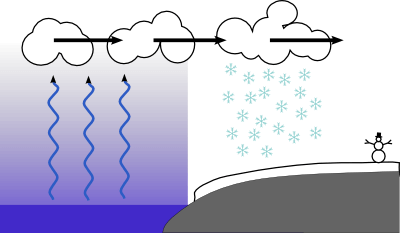When it comes to Buffalo weather, the city is known for its snowfall, and for good reason. But many out-of-towners don’t realize that our city should be just as well known for cloudy weather.
While the Pacific Northwest gets a lot of recognition for being cloudy, Buffalo actually has more cloudy days per year than any other large city in the U.S., according to Current Results. Buffalo has 311 days per year (or 85% of the year) of “partial cloud,” which means that clouds cover anywhere from over one-quarter to as much as three-quarters of the sky on these days.
In terms of the number of days of “heavy cloud,” when cloud covers over three-quarters of the sky, Buffalo ranks third nationally with 208 days per year, right behind the notoriously overcast cities of Seattle and Portland.
With cloudy weather becoming more frequent in October, and winter not far off, we thought it would be interesting to examine why Buffalo is so cloudy and how clouds form here as a result of the city’s unique geography and topography. While you’re probably not looking forward to the overcast weather, we hope you’ll gain a better appreciation and understanding of Buffalo’s climate.
Blame the Great Lakes For WNY’s Clouds
According to the National Weather Service, cold fronts from Canada become more common in late October, and as the cold air passes over the warmer Great Lakes, cloud cover in Buffalo and WNY increases drastically. This is what effectively begins the “lake effect” season, which often leads to lake effect snowstorms later in fall and winter.
Lake effect snow in Buffalo and Western New York occurs when cold air crosses the relatively warm waters of Lake Erie and Lake Ontario and becomes saturated, creating clouds and precipitation downwind. These snowbands are often highly localized, since their location is determined by the direction of the wind.

According to Wikipedia, cold winds in the winter typically prevail from the northwest in this region, which is why areas south of Buffalo also receive much more lake effect snow than locations to the north. While we usually don’t see measurable snowfall in Buffalo until November, the increased cloudiness you see in October is a result of this same process.
Prevailing winds from the northwest also result in more lake effect snow and increased cloudiness on the southern and eastern shores of the Great Lakes compared to the northern and western shores. This explains why cities such as Detroit, Toledo, Milwaukee and Chicago, on the west side of the Great Lakes, receive less snow and are less cloudy than Buffalo, which borders the east shore of Lake Erie, according to the Washington Post.
Buffalo Clouds vs. Other Cities
Scott Steiger, a meteorology professor at SUNY Oswego, told NewYorkUpstate.com that the Great Lakes are to blame for the Buffalo region’s intense cloudiness in late fall through winter and early spring. That’s because cold air blowing across the Great Lakes during this time picks up moisture, and that moisture condenses into water droplets that form clouds.
When comparing Upstate New York cities like Buffalo to cities at about the same latitude but that don’t lie downwind of the lakes, Steiger tells New York Upstate you can see huge differences in the amount of cloud cover and sunlight during the colder months, which shows the enormous impact the Great Lakes have on the local climate.
A non-Great Lakes comparison Steiger mentions gives is Sioux Falls, S.D., which gets 56 percent of possible sunshine throughout the year, more than Buffalo or any other city in Upstate NY, according to the website. It also gets about twice as much sunshine in the winter as Buffalo does.
This lake effect phenomenon also explains why the Buffalo region isn’t nearly as cloudy during late spring and summer — the air is warmer and thus doesn’t pick up as much moisture, so the Great Lakes don’t produce the same level of clouds.
In fact, in the warmer months, the Great Lakes actually have a stabilizing effect on the weather because they remain cool for a large part of the summer.. In the summer, Upstate New York receives sunlight 60 percent or more of the time, more than double the available sunshine during the winter, according to NewYorkUpstate. Buffalo actually has the sunniest and driest summers of any major city in the Northeast, according to the National Weather Service.
How Local Topography Affects Cloud Cover
Local topography also plays a role in fall and winter cloud cover in WNY, according to WIVB.
They explain that orographic lifting results in cloudiness across Buffalo and Niagara Falls in the cooler months. Orographic lifting results when cool air is forced from a lower elevation to a higher elevation as it moves over a mountain or hilltop. If the air cools enough, it will start to condense and clouds will form.
In late fall and early winter, warm water from the lakes creates unstable conditions. A northwesterly wind flow brings colder air over the warm waters of Lake Ontario, allowing the air to rise over the Niagara Escarpment. This creates a significant amount of cloud cover in the Niagara region.
Similarly, when a southwesterly wind flow develops and brings cold air over the warm waters of Lake Erie into Chautauqua County, the Chautauqua Escarpment helps the air mass quickly rise, causing clouds to develop across the Southern counties.
Fighting the Winter Blues
While Buffalo’s impending cloudiness might want to make you crawl into bed until spring, there are ways to combat the negative impacts of gloomy weather. A lack of sunlight can impact your mood, sleep and productivity, so it’s important to take steps to prevent the winter blues that are so common in cold, cloudy cities.
Now that you have a better understanding of Buffalo’s cloudiness and what creates it, perhaps you’ll appreciate its sunny days that much more. Be sure to get outside as much as you can and take advantage of our mild fall weather before the gray, cloudy days of winter approach.

 Fair Housing Notice
Fair Housing Notice 